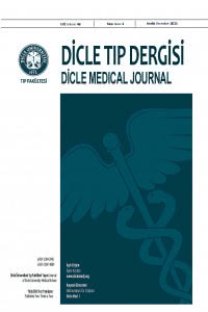The Relationship Between MicroRNAs And Congenital Kidney Anomalies
MikroRNA’lar ve Doğuştan Böbrek Anomalileri Arasındaki İlişki
___
1. Vivante A, Kohl S, Hwang DY, Dworschak GC, Hildebrandt F. Single-genecauses of congenital anomalies of the kidney and urinary tract (CAKUT) in humans. Pediatr Nephrol. 2014; 29: 695-704.2. Ho J, Kreidberg JA. MicroRNAs in renal development. Pediatr Nephrol. 2013; 28: 219- 25.
3. Dias T, Sairam S, Kumarasiri S. Ultrasound diagnosis of fetal renal abnormalities. Best Pract Res Clin Obstet Gynaecol. 2014; 28: 403-15.
4. van de Hoek G, Nicolaou N, Giles RH, Knoers NV, Renkema KY, Bongers EM. Functional models for congenital anomalies of the kidney and urinary tract. Nephron. 2015; 129: 62-7.
5. dos Santos Junior AC, de Miranda DM, Simões e Silva AC. Congenital anomalies of the kidney and urinary tract: an embryogenetic review. Birth Defects Res C Embryo Today. 2014; 102: 374-81.
6. Caruana G, Bertram JF. Congenital anomalies of the kidney and urinary tract genetics in mice and men. Nephrology (Carlton). 2015; 20: 309- 11.
7. Baldassarre A, Felli C, Prantera G, Masotti A. Circulating microRNAs and Bioinformatics Tools to Discover Novel Diagnostic Biomarkers of Pediatric Diseases. Genes (Basel). 2017; 8: 234.
8. Makarova JA, Shkurnikov MU, Turchinovich AA, Tonevitsky AG, Grigoriev AI. Circulating microRNAs. Biochemistry (Mosc). 2015; 80: 1117-26.
9. Ivey KN, Srivastava D. microRNAs as Developmental Regulators. Cold Spring Harb Perspect Biol. 2015; 7: a008144.
10. Van der Hauwaert C, Savary G, Hennino MF, Pottier N, Glowacki F, Cauffiez C. MicroRNAs in kidney fibrosis. Nephrol Ther. 2015; 11: 474-82.
11. Kito N, Endo K, Ikesue M, Weng H, Iwai N. miRNA Profiles of Tubular Cells: Diagnosis of Kidney Injury. Biomed Res Int. 2015; 2015: 465479.
12. Akkina S, Becker BN. MicroRNAs in kidney function and disease. Transl Res. 2011; 157: 236-40.
13. Badal SS, Danesh FR. MicroRNAs and their applications in kidney diseases. Pediatr Nephrol. 2015; 30: 727-40.
14. Trionfini P, Benigni A, Remuzzi G. MicroRNAs in kidney physiology and disease. Nat Rev Nephrol. 2015; 11: 23-33.
15. Bhatt K, Kato M, Natarajan R. Mini-review: emerging roles of microRNAs in the pathophysiology of renal diseases. Am J Physiol Renal Physiol. 2016; 310: 109-18.
16. Ho J, Pandey P, Schatton T, et al. The proapoptotic protein Bim is a MicroRNA target in kidney progenitors. J Am Soc Nephrol. 2011; 22: 1053–63.
17. Nagalakshmi VK, Ren Q, Pugh MM, Valerius MT, McMahon AP, Yu J. Dicer regulates the development of nephrogenic and ureteric compartments in the mammalian kidney. Kidney Int. 2011; 79: 317-30.
18. Zhao H, Ma SX, Shang YQ, Zhang HQ, Su W. micro RNAs in chronic kidney disease. Clin Chim Acta. 2019; 491: 59-65.
19. Hartung EA, Guay-Woodford LM. Autosomal recessive polycystic kidney disease: a hepatorenal fibrocystic disorder with pleiotropic effects. Pediatrics. 2014; 134: 833- 45.
20. Pandey P, Brors B, Srivastava PK, et al. Microarray-based approach identifies microRNAs and their target functional patterns in polycystic kidney disease. BMC Genomics. 2008; 9: 624.
21. Sun H, Li QW, Lv XY, et al. MicroRNA-17 posttranscriptionally regulates polycystic kidney disease-2 gene and promotes cell proliferation. MolBiol Rep. 2010; 37: 2951–8.
22. Lee SO, Masyuk T, Splinter P, et al. MicroRNA15a modulates expression of the cellcycle regulator Cdc25A and affects hepatic cystogenesis in a rat model of polycystic kidney disease. J Clin Invest. 2008; 118: 3714–24.
23. Ho J, Pandey P, Schatton T, et al. The proapoptotic protein Bim is a MicroRNA target in kidney progenitors. J Am Soc Nephrol. 2011; 22: 1053–63.
24. Zhu S, Cao L, Zhu J, et al. Identification of maternal serum microRNAs as novel noninvasive biomarkers for prenatal detection of fetal congenital heart defects. Clin Chim Acta. 2013; 424: 66-72.
25. Song Y, Higgins H, Guo J, et al. Clinical significance of circulating microRNAs as markers in detecting and predicting congenital heart defects in children. J Transl Med. 2018; 2: 42.
26. Wojciechowska A, Braniewska A, KozarKamińska K. MicroRNA in cardiovascular biology and disease. Adv Clin Exp Med. 2017; 26: 865-74.
27. Weber DG, Casjens S, Rozynek P, et al. Assessment of mRNA and microRNA Stabilization in Peripheral Human Blood for Multicenter Studies and Biobanks. Biomark Insights. 2010; 5: 95-102.
- ISSN: 1300-2945
- Yayın Aralığı: 4
- Başlangıç: 1963
- Yayıncı: Cahfer GÜLOĞLU
MikroRNA’lar ve Doğuştan Böbrek Anomalileri Arasındaki İlişki
Zübeyde GÜNDÜZ, Ruhan DÜŞÜNSEL, Sibel YEL, Kenan YILMAZ, Mehmet Serdar KUTUK, İsmail DURSUN
Malign Plevral Mezotelyomada Metabolik PET Parametrelerinin Sağkalım Üzerine Etkisi
Şahin LAÇİN, Abdurrahman IŞIKDOĞAN, Nadiye AKDENİZ, Mehmet KÜÇÜKÖNER, Muhammet Ali KAPLAN, Zuhat URAKÇI, Oğur KARHAN, Halis YERLİKAYA, Halil KÖMEK
Nizamettin Selçuk YELGEÇ, Mehmet Baran KARATAŞ, Can Yücel KARABAY, Yiğit ÇANGA, Ali Nazmi ÇALIK, Barış ŞİMŞEK, Özge GÜZELBURÇ, Ayşe MERE
Kliniğimizde Cerrahi Olarak Tedavi Edilen Göz Kapağı Tümörlerinin Histopatolojik Bulguları
Dilek UZLU, Nurettin AKYOL, Mustafa Emre ERCİN, Adem TÜRK, Halil İbrahim İMAMOĞLU
Kahraman COŞANSU, Cagın Mustafa UREYEN, Harun KILIÇ, Bilgehan KARADAĞ, Ayca TURER CABBAR, Huseyin GUNDUZ, Rmazan AKDEMİR
Cerrahi Olarak Tedavi Edilen Distal Radius Kırıklarının Klinik Profili
Nurullah PEKER, Gökçe TURAN, Edip AYDIN, Mustafa YAVUZ, Serhat EGE, Muhammet Hanifi BADEMKIRAN, Talip KARACOR, Talip GÜL
Pulmoner Arteriyal Hipertansiyon Hastalarında Serum D vitamini Düzeyleri
Ümit Yaşar SİNAN, İsmail Polat CANBOLAT, Ayşem KAYA
Mine KARAHAN, Seyfettin ERDEM, Sedat AVA, Mehmet Emin DURSUN, Zülküf KARAHAN, Atılım Armağan DEMİRTAŞ, Uğur KEKLİKÇİ
